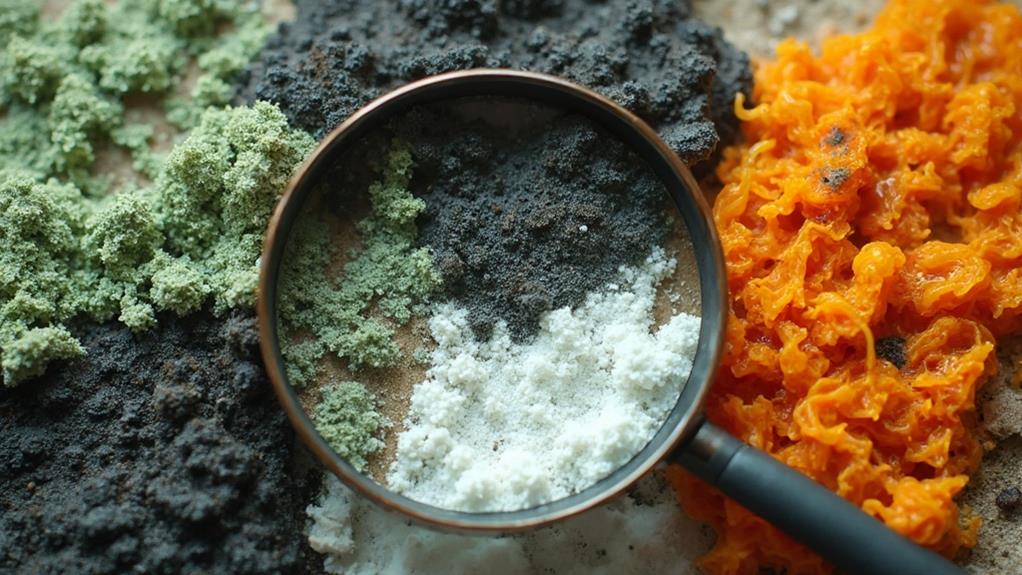Identifying different types of mold in your home involves recognizing their distinct characteristics. Common household molds include Aspergillus, Penicillium, Cladosporium, Alternaria, and Stachybotrys (black mold). These can appear as green, white, brown, or black patches on various surfaces. Black mold is particularly concerning due to its potential health risks. White molds often have a fuzzy texture, while green molds are typically found in damp areas. Visual inspection, odor detection, and moisture assessment are key to identifying mold growth. Professional testing may be necessary for accurate identification and to determine the extent of the problem. Understanding these mold types is crucial for effective prevention and remediation strategies.
Common Household Mold Types

There are five prevalent types of mold commonly found in households: Aspergillus, Penicillium, Cladosporium, Alternaria, and Stachybotrys.
Aspergillus is a genus comprising hundreds of species, often appearing as green, gray, or white patches. It thrives in damp environments and can cause respiratory issues.
Penicillium, recognizable by its blue or green color, is frequently found on food items and in water-damaged areas. While some species are beneficial, others can produce mycotoxins harmful to health.
Cladosporium, typically olive-green or brown, grows on fabrics, wood, and damp surfaces. It can trigger allergic reactions and exacerbate asthma symptoms.
Alternaria, a dark brown or gray mold, often develops in damp areas like bathrooms and basements. It's a common allergen and can cause respiratory problems.
Stachybotrys, known as "black mold," is the most notorious. It appears slimy and black, thriving in areas with prolonged moisture exposure. This mold produces potent mycotoxins and is associated with severe health effects, including respiratory distress and neurological symptoms.
Identifying these mold types is crucial for effective remediation and protecting occupants' health.
Identifying Black Mold
Among the various mold types, black mold stands out as particularly concerning due to its potential health risks. Scientifically known as Stachybotrys chartarum, this fungus thrives in damp, humid environments with high cellulose content. It typically appears as dark green or black patches with a slimy or fuzzy texture on surfaces like drywall, wood, or paper.
Identifying black mold requires careful observation. Look for circular spots that may coalesce into larger areas, often accompanied by a musty odor. While not all dark-colored molds are Stachybotrys, any suspicious growth should be treated cautiously. Common locations for black mold include bathrooms, basements, and areas affected by water damage or leaks.
To confirm the presence of black mold, professional testing is recommended. However, visible mold growth of any color should be addressed promptly. If you suspect black mold in your home, it's crucial to avoid direct contact and seek expert assistance for safe removal. Prevention involves controlling moisture levels, improving ventilation, and addressing water issues immediately to inhibit mold growth and protect your health and home.
White Mold Varieties
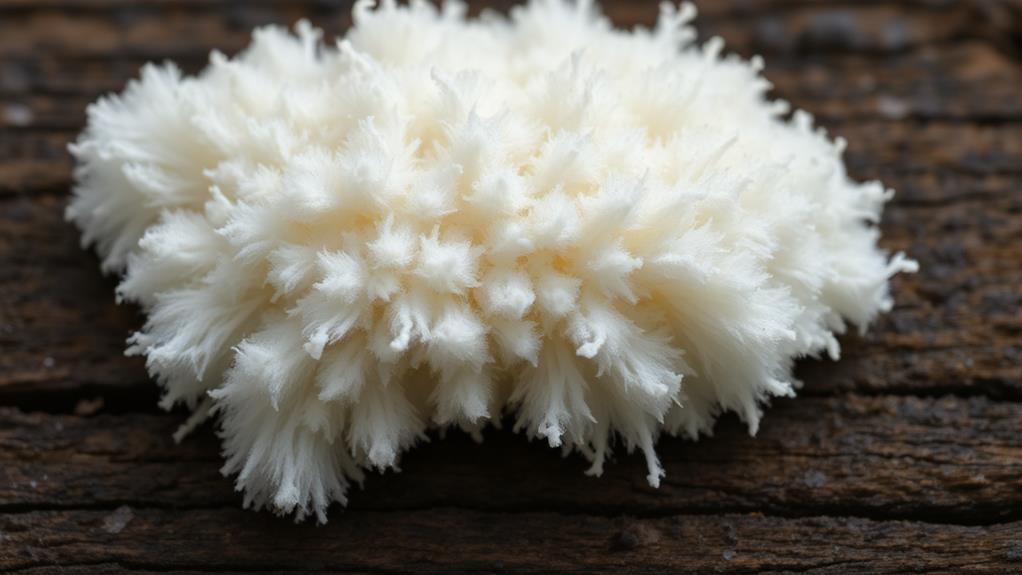
While black mold often garners significant attention, white mold varieties also pose potential risks to homes and occupants. White mold encompasses several species, including Penicillium, Aspergillus, and Cladosporium. These fungi thrive in moist environments and can spread rapidly on various surfaces.
Penicillium, known for its fuzzy appearance, commonly grows on food and damp building materials. It can cause allergic reactions and respiratory issues in sensitive individuals.
Aspergillus, another prevalent white mold, is often found on fabrics, walls, and air conditioning systems. Some Aspergillus species produce mycotoxins, potentially leading to more severe health problems.
Cladosporium, while typically appearing greenish-brown, can also manifest as white mold. It frequently colonizes bathrooms, kitchens, and basements due to high humidity levels. This mold species may trigger asthma attacks and other respiratory symptoms.
To identify white mold, look for powdery or fluffy patches on surfaces. Unlike efflorescence, which is a harmless mineral deposit, white mold feels soft and may leave residue when touched. Proper identification is crucial for effective remediation and preventing further spread of these potentially harmful fungi.
Green Mold Species
Green mold species represent another category of fungi commonly found in homes, with three primary types being Aspergillus, Penicillium, and Cladosporium. These molds thrive in damp, humid environments and can often be found on food, walls, and other surfaces.
Aspergillus is a widespread genus with over 185 species, some of which can produce harmful mycotoxins. It frequently appears on houseplants, textiles, and air conditioning systems. Penicillium, known for its role in antibiotic production, can also be problematic in indoor environments. It often grows on fruits, breads, and cheeses, and can spread quickly in moist areas.
Cladosporium is typically found outdoors but can enter homes through open windows or on clothing. It tends to grow on fabrics, wood, and damp areas in bathrooms and basements. While less toxic than some other mold species, it can still cause allergic reactions and respiratory issues in sensitive individuals. Identifying these green mold species is crucial for effective remediation. Professional testing may be necessary to distinguish between types, as their appearance can be similar. Prompt action is essential to prevent further growth and potential health risks associated with prolonged exposure to these common household molds.
Health Risks of Mold Exposure
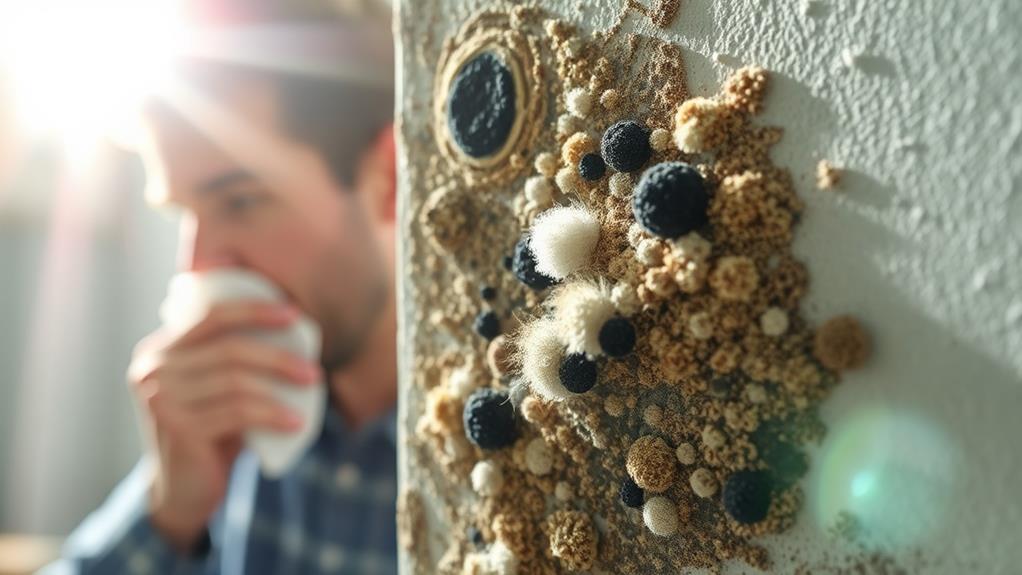
Exposure to mold in indoor environments can lead to various health risks, ranging from mild allergic reactions to severe respiratory issues. Common symptoms of mold exposure include nasal congestion, coughing, wheezing, throat irritation, and eye irritation.
For individuals with allergies or asthma, mold can trigger more severe reactions, exacerbating existing conditions.
Prolonged exposure to certain types of mold, particularly those that produce mycotoxins, can result in more serious health problems. These may include chronic sinus infections, bronchitis, and in rare cases, neurological symptoms. Immunocompromised individuals, young children, and the elderly are particularly susceptible to mold-related health issues.
Black mold, specifically Stachybotrys chartarum, has gained notoriety for its potential to cause severe health problems. While its dangers are often exaggerated, exposure to large amounts of black mold can lead to respiratory distress and other complications.
It's important to note that the health effects of mold exposure can vary greatly depending on the individual's sensitivity, the type and amount of mold present, and the duration of exposure. If you suspect mold growth in your home, it's crucial to address the issue promptly to minimize potential health risks.
Mold Growth Conditions
The proliferation of mold in indoor environments hinges on specific conditions that foster its growth. Moisture is the primary catalyst for mold development, with water-damaged areas being particularly susceptible. Relative humidity levels above 60% create an ideal atmosphere for mold spores to thrive. Additionally, mold requires organic matter as a food source, which can include wood, paper, fabric, and even dust.
Temperature also plays a crucial role in mold growth, with most species flourishing between 60°F and 80°F. However, some molds can survive in temperatures as low as 32°F or as high as 120°F. Poor ventilation exacerbates mold issues by trapping moisture and limiting air circulation. Dark environments further promote mold growth, as many species prefer low-light conditions.
Common areas prone to mold growth include bathrooms, kitchens, basements, and attics due to their higher moisture levels and potential for water damage. Leaky pipes, roof damage, and condensation on windows or walls can create localized mold-friendly microclimates. Understanding these growth conditions is essential for homeowners to effectively prevent and address mold issues in their living spaces.
DIY Mold Detection Methods
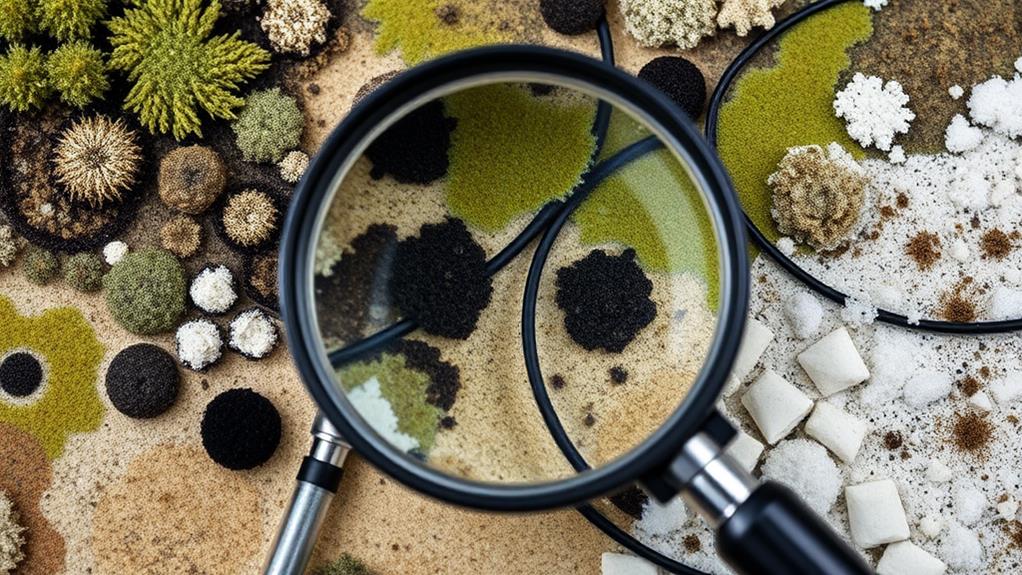
Several effective do-it-yourself methods exist for detecting mold in residential environments. Visual inspection is the primary technique, involving a thorough examination of potential problem areas such as bathrooms, basements, and areas with water damage. Look for visible signs of mold growth, including discoloration, fuzzy patches, or water stains on walls, ceilings, and floors.
The smell test is another useful method. Mold often produces a distinct musty odor, which can be particularly noticeable in enclosed spaces. If you detect a persistent, earthy smell, it may indicate hidden mold growth. Additionally, moisture meters can help identify areas of high humidity or dampness, which are conducive to mold growth.
For more precise detection, homeowners can use mold testing kits available at hardware stores. These kits typically include swabs or tape strips to collect samples from surfaces, which are then sent to a laboratory for analysis. While not as comprehensive as professional testing, DIY kits can provide valuable information about the presence and types of mold in your home. However, for extensive or potentially dangerous mold infestations, it's advisable to consult a professional mold inspector for a thorough assessment and remediation plan.
Professional Mold Testing Options
While DIY methods can be helpful, professional mold testing offers a more comprehensive and accurate assessment of mold issues in your home. Professional mold inspectors use specialized equipment and techniques to detect mold growth, even in hidden areas.
One common professional testing method is air sampling, which involves collecting air samples from various locations in the home. These samples are then analyzed in a laboratory to identify the types and concentrations of mold spores present. Surface sampling is another technique used by professionals, where swabs or tape lifts are used to collect samples directly from visible mold growth or suspicious areas.
Professionals may also employ moisture meters to detect elevated moisture levels in walls, floors, and ceilings, as these areas are prone to mold growth. Thermal imaging cameras can be used to identify temperature differences that may indicate hidden moisture or mold issues.
In addition to these testing methods, professional mold inspectors provide expert analysis of the results and offer recommendations for remediation. They can also help identify the underlying causes of mold growth, such as water leaks or inadequate ventilation, to prevent future issues.
Preventing Mold in Your Home
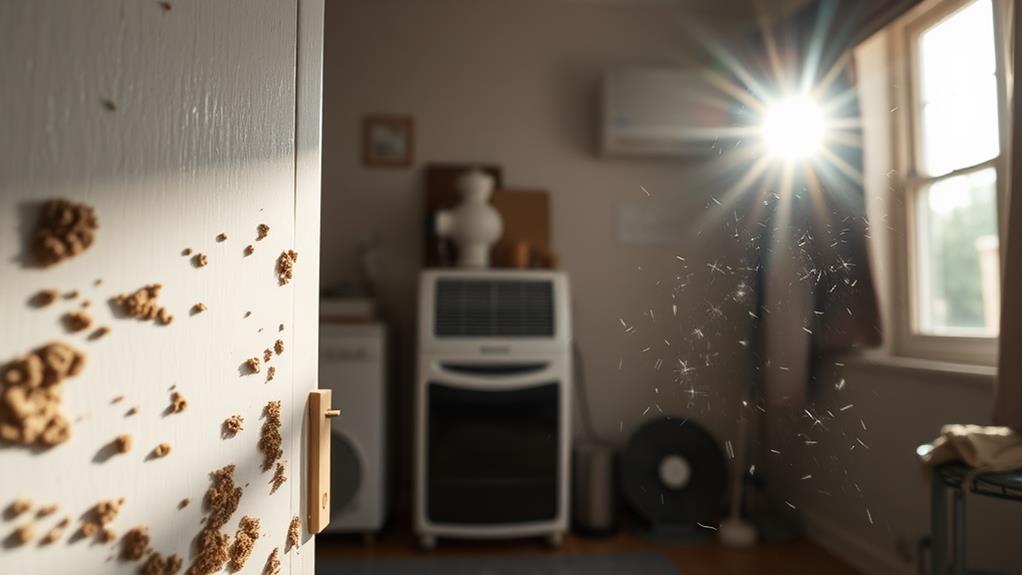
To effectively prevent mold in your home, implementing proactive measures is essential. Begin by controlling moisture levels, as mold thrives in damp environments. Use dehumidifiers in humid areas, fix leaks promptly, and ensure proper ventilation in bathrooms and kitchens. Maintain indoor humidity below 60%, ideally between 30-50%.
Regularly inspect your home for signs of water damage or excessive moisture. Pay close attention to basements, crawl spaces, and attics. Clean and dry any wet areas within 24-48 hours to prevent mold growth. Use mold-resistant products when renovating or building, such as mold-resistant drywall and paint.
Improve air circulation by opening windows and using fans. Keep air conditioning drip pans clean and ensure that drain lines remain unobstructed. Avoid carpet in damp areas like bathrooms and basements. Clean and dust your home regularly, focusing on mold-prone areas.
Outside your home, ensure proper drainage away from the foundation. Clean gutters regularly and repair any damaged roof shingles. By implementing these preventive measures, you can significantly reduce the risk of mold growth in your home, maintaining a healthier living environment.
Effective Mold Removal Techniques
Despite preventive measures, mold can sometimes develop in homes, necessitating effective removal techniques. For small areas of mold growth, a simple solution of water and detergent can be effective. Scrub the affected area with a stiff brush, then rinse and dry thoroughly.
For larger or more persistent mold problems, stronger solutions may be required. A mixture of one cup of bleach per gallon of water is often recommended for non-porous surfaces.
For porous materials like drywall or carpet, removal and replacement may be necessary if mold has penetrated deeply. When dealing with extensive mold growth, it's advisable to consult professional mold remediation services. These experts have specialized equipment and knowledge to safely remove mold and prevent its recurrence.
Always wear protective gear, including gloves, goggles, and a respirator mask, when cleaning mold. Ensure proper ventilation during the cleaning process. After removal, address the underlying moisture issue to prevent future mold growth. In cases of toxic mold or health concerns, it's crucial to seek professional help. Regular inspection and prompt action can help maintain a mold-free living environment.
Frequently Asked Questions
Can Mold Grow on Synthetic Materials Like Plastic or Polyester?
Yes, mold can grow on synthetic materials like plastic and polyester. While these surfaces don't provide nutrients, mold can thrive on organic debris or moisture accumulated on them. Proper cleaning and moisture control are essential to prevent mold growth.
How Quickly Can Mold Spread Throughout a Home?
In a severe case, a flooded basement led to extensive mold growth within 48 hours. Mold can spread rapidly, often within 24-72 hours under ideal conditions. Factors like moisture, temperature, and surface type influence the speed of proliferation.
Are There Any Mold-Resistant Plants That Can Help Purify Indoor Air?
Several plants can help purify indoor air and resist mold growth, including spider plants, peace lilies, and Boston ferns. These plants absorb excess moisture and filter air pollutants, potentially reducing mold spores and improving overall air quality in your home.
Can Pets Carry Mold Spores and Contribute to Household Mold Problems?
Yes, pets can carry mold spores on their fur or paws, potentially contributing to household mold issues. Regular grooming, cleaning pet bedding, and maintaining proper hygiene can help minimize the risk of pets introducing mold spores into the home.
Does Mold Have Any Positive Uses or Applications in Everyday Life?
Like a jack-of-all-trades, mold serves various beneficial purposes in everyday life. It's crucial in food production, creating cheeses and fermented products. Mold is also utilized in medicine, particularly for antibiotics, and plays a role in biodegradation processes.
Conclusion
In conclusion, vigilance and prompt action are paramount in combating the insidious threat of household mold. Like a silent invader, mold can compromise both structural integrity and occupant health. By familiarizing oneself with various mold types, employing detection methods, and implementing preventive measures, homeowners can create a safer living environment. When in doubt, professional assessment and remediation offer the most comprehensive solution. Ultimately, a proactive approach to mold management ensures a healthier, more secure home for all inhabitants.
